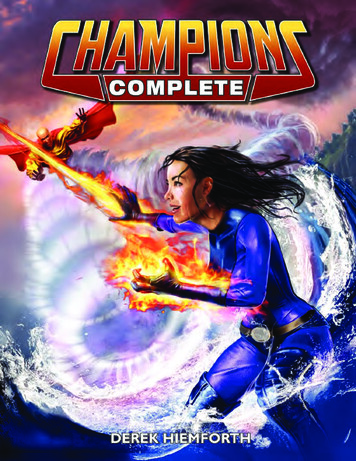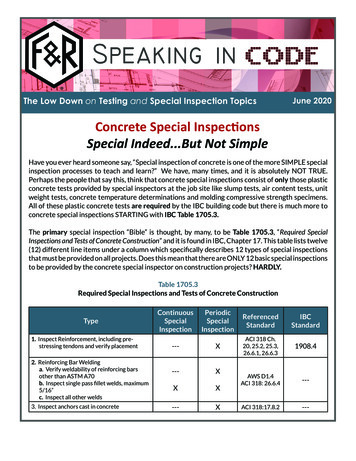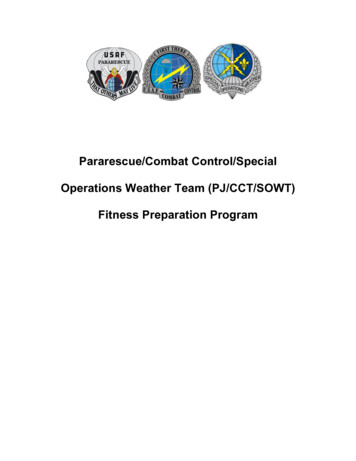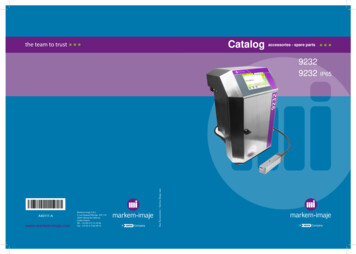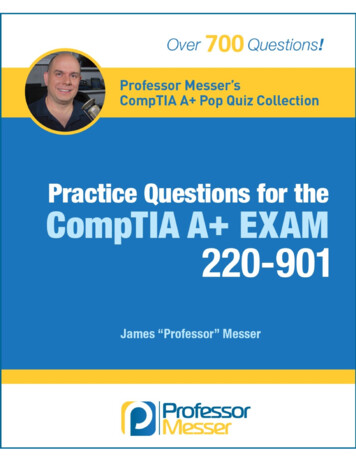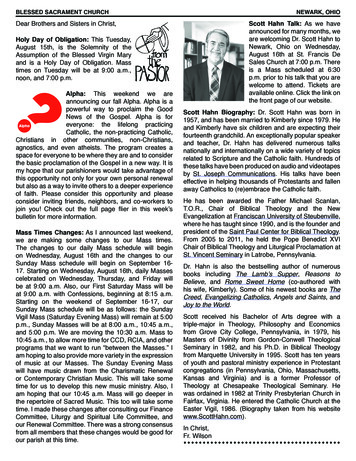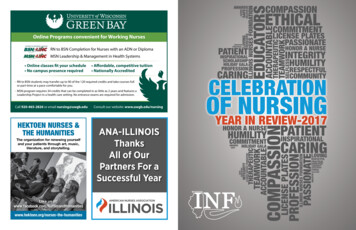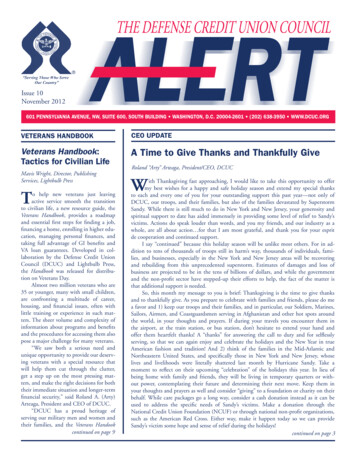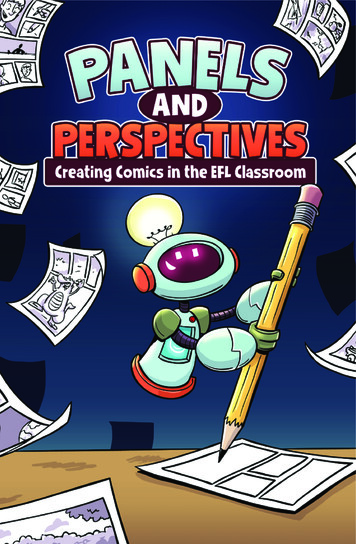
Transcription
2019 by the Office of English Language Programs.Panels and Perspectives:Creating Comics in the EFL Classroom.This work is licensed under the CreativeCommons Attribution 4.0 License, except where noted.To view a copy of this license, CREATIVE TEAM:SPECIAL THANKS:Illustrator: Joshua AlvesWriter: Daniel RyderEditor: Jacqueline GardyAdvisor: Diane MillarJoseph BookbinderThis publication is available free of charge online at:americanenglish.state.govOffice of English Language ProgramsBureau of Educational and Cultural AffairsUnited States Department of StateWashington, D.C.U.S. Department of Stateamericanenglish.state.gov
MEET O.R.I.Our Robot Instructor isready to take you on aninstructional tour aboutcomic books. learn howto use them and createthem in your classroom!What’s Inside:Pages 1-3IntroductionPages 4-5HistoryPages 9-11Tools to MakeComic BooksPages 12-17StorytellingCreated by:Dan Ryder WrIterJosh Alves ArtistJacqueline Gardy editorPages 6-8Structure ofComic BooksPages 18-22Why and Howto MakeComic Books
Comics are everywhere these days.Our theaters.OUR DEVICES.even Our closets.And for peoplewho haven’t readcomics before.It can beoverwhelming.1
RELAX.CLOSE YOUR EYES.EXHALE.TAKE A BREATH.IF YOU ARE THE ONEmaking comics.OPEN YOUR EYESAND REMEMBER.2
COMICS CAN BEANYTHING.3
WAY BACK THENCOMICS, AT THEIR CORE,ARE SEQUENTIAL ART: A SERIESOF IMAGES AND WORDS USEDTO COMMUNICATE.And thIs is just whatpeople have been doing forcenturies -- communicatingthrough comics!Prehistoric cavedwellers used doodlesto share stories ofhunts and daily life.The ancient egyptiansused hieroglyphics to recordinformation about harvestseasons and business deals.The moche people ofsouth america decorated theirceramics with biographiesand religious stories,And medieval europeansembroidered and wovetheir histories intotapestries and fabrics.
RIGHT ABOUT NOWAs more materials became available andthe ability to share art became easier,these and other forms of visualstorytelling transformed and expanded.Chinese and japanesescholars and artistsdeveloped cartoons andillustrated stories onscrolls, becoming thefoundations for manhuaand manga.Europeans used printing pressesto distribute political cartoonsand religious allegories, which inturn led to picture books, comicstrips, and illustrated novels.And in the United states,newspaper comic stripsbecame so popular they werereprinted in small books.Those small books were sopopular, publishers decided tostop paying newspapers fortheir strips and just createdtheir own comic books.Almost every culture hasa history with sequestial art,and comics can often be understoodwithout any words at all.nowadays, many comic charactersare universally recognized.
Just like a livingcreature or a machine,comics have an anatomy.And just like baking aloaf of bread orconstructing a safehome, the more comicbook creators knowabout how the parts andpieces of comics worktogether, the betterthe product! one of themain ingredients of acomic isa panel typicallycontains one sceneThe shape andof a story. a pageborderare used tomay have one orhelpconveyvisualmany panels.information. forexample, a wavyborder usuallyreferences a dreamor a flashback.Speech Bubblesare the standardcontainer fordialogue.like panelspanels,, theborders cancommunicate howthe dialogue isbeing spoken.Extra lines used toconvey emotion andmovement are called.lines showingmovement.PIE.Hot PIE.Lines showingemotion.6
WHEN PLANNINGTHE LAYOUT OFA COMIC PAGE,PANELS ARE USEDto help directTHE READER’SEYES.Panels are readin a SIMILAR orderand direction asprose books.Panels alsohelp establishthe rhythm ofa page.BIg panels have a lot of roomand give readers a place to rest.The bigger the panel, the moretIme and attention it is given.Multiplesmall panelscan be usedto create.Suspense.7
And this bringsus to the magicalspace between thepanels that makescomics uniqueThose readerscan follow rightalong, even if.COMICS TELLSTORIES.OUR BRAINS FILLIN THESE “GUTTERS”WITH THE STORYWE CAN’T SEE.THAT MEANS.YOU PLAYwith time.ExplainPROCESSES.8IF YOU GIVE YOURREADER ENOUGHVISUAL CLUES.OR LOCATION.And provideinformation.
No matter how much, orhow little money, talentor technology you have,there are lots of waysto make comics!9
There are all sortsof ordinary tools andmaterials you can useto make comics.Many comic bookcreators usetraditional artSUPPLIES.While somego digital andothers.In fact, you canmake comics outof just aboutanything.Even stuffsomeone elsemight throwaway.Go with whateverthey can find.The best kept secretabout making comicsIs any way you makethem is the right wayto make them!10
Brainstorming& organizingDOODLINGCharacterCREATIONAre you ready to makeYOUR OWN COMICS?These are justsome of the stepsyou might take inthe process ofcreatIng them.StoryboardingSCRIPTINGLAYOUTSWorld building11Publishing
We can make comicsabout any theme ortopic. That’s part ofwhat makes ts!Monsters!ALIENS!Superheroes!12Adventure!
However, sometimesthe best stories.Are those closest.to home.13
When we tell storiesabout our lives, webecome experts.We know thedialogue and thesettings inside andout because wehave lived them.When studentsworry about theircomics not beinggood enough, wecan say to them.No oneelse knowsmore than youabout how youfelt that day.and no oneelse can drawthat scene theway you can.Memoir comicsmake them thesmartest creatorsin the entire world.14
Even though students areexperts in their own lives.They may stillhave difficultyempathizing withothers -- seeingthe world fromother pointsof view.Creating biographicalcomics gives studentsopportunities topractice their listeningand empathy skills atthe same time.15
Good stories are allabout describing problemsand solving them.The story of a problemincludes three things:There arefour basic typesof conflict.Person vspersonPerson vsselfPerson vsSOCIETYPerson vsEnvironmentAnd great storytellersshow their readershow a conflict starts .16
How a conflict intensifies and builds to climax-- A point of maximum interest for the audience -- and then .Reaches a resolution! The conflict comes to an endand the characters have learned or gainedsomething important -- knowledge, experience,understanding or something else.Good stories leave thecharacters in a different placefrom where they started.17
Students of all backgroundshave difficulty learningEven if they score wellnew skills and informationon a test or answer everywhen they feel disconnectedquestion in class, studentsfrom the material andneed a personal connectionoverwhelmed by unfamiliarto make sense of theirlanguage and ideas.knowledge and use thoseskills in the future.Even though studentsmay struggle tolearn new languageand concepts, theyare experts in manyother ways.They know about the foods theyeat and communities where they live,they know their traditions andtheir values, and they know theirstrengths and their challenges.Comics are a powerful way forstudents to use their expertiseto make connections to newunderstanding.18
Comics can make it easier toshow similarities and differences.abdi made this comic to show howfood culture can differ fromone country to the next.When Iam readyfor my middaymeal.When manyamericans areready for amidday mealInstead of walkingto a market, they orderfood and have it deliveredto their work, or theybring their midday mealfrom home.I walk to themarketplace andsee which vendorsare selling.I choose somethingI can afford and eat it rightthere in the middle of the market;I talk to the vendors and hearwhat is happening todayaround town.19Just like me, theylike to talk during theirmidday meal and find outwhat is happening in thelives of the peoplethey know.
Comics help studentsvisualize the benefits andrisks of making a decision.when students can picturethemselves making one or twochoices, then they are oftenable to think of more options-- and more consequences -than they had realizedAftergraduatingfrom school,I am going toneed moneybecausegetting aneducation canbe expensive.OPTION 1:Ask relativesto borrowmoney.Benefit:relatives feelgood helping.RISK:relatives afraidto say no.BENEFIT:CLOSE TO HOME.RISK:LOW WAGES.BENEFIT:BETTER PAY.RISK:COSTS MORE TOlive in the city.OPTION 2:FIND JOBIN TOWNOPTION 3:Find a job in amore WealthycityDrawing comics makes iteasier to predict possibleoutcomes because students have toslow down their thinking and ask,“How might I explain this in adrawing?” They have to considerall of the little details anddecide, “what really matters?”20
When studentsstart thinking about howthey make decisions, theyalso start to examinetheir beliefs and values,their opinions and ideas.Through symbols, colors,imagery and metaphors,creating comics helpsstudents who may struggleto explain their thoughtsand feelings when onlyusing words.Hannah believesall girls deserve aneducation but when herfamily asks her whyshe gets quiet andapologetic. SheCreated this comic tohelp them understandher point of view.When I’m athome, my olderbrothers do the mostimportant chores, getto go shopping withmy uncle, and helpmake importantdecisions.I feel like alittle kitten kept ina very nice basket.Everyone is nice tome and treats mewell. However, noone takes meseriously.When I’m atschool, I help myclassmates learndifficult mathbecause numbersmake more sense tome than words.School makesme feel strongand powerful, likea rocket headed tothe stars or theengine of a boatcarrying peopleacross theocean.I think everygirl should getthe chance tofeel that way -important,powerful andhelpful.21
Making comicshelps studentscommunicateideas.And makemeaning in ourworld.Solveproblems.In other words, creatingcomics develops authenticliteracy skills through apowerful means ofcommunication.The universallanguage of comics!22
Combining the written word witheven the most simple doodles can bea powerful tool for students learningEnglish. Panels and Perspectives:Creating Comics in the EFL Classroomis an instructional guide foreducators with insights, strategies,and practical applications for makingcomics in any English languageclassroom. Discover theeducational power of comics!U.S. Department of Stateamericanenglish.state.gov
reprinted in small books. Those small books were so popular, publishers decided to stop paying newspapers for their strips and just created their own comic books. Almost every culture has a history with sequestial art, and comics can often be understood without any words at all. nowadays, many
